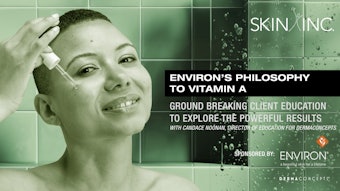
The science behind the pursuit of youthful skin is ever-evolving. Americans have come to rely on the skin care industry having a new breakthrough around every corner.
Truth be told, new scientific discoveries that will ultimately change the way skin ages—or doesn’t—do not happen every day. Then, even when an exciting ingredient appears on the stage, it takes at least a few large-scale double-blind studies to prove the hypothesis of what benefit it might provide to human skin. There are ingredients, some long-standing and some new, that having proven their efficacy or have sparked interest in further study. Learning to rely on science and not marketing is the best way for skin care professionals and clients alike to identify truly effective skin care ingredients.
New isn’t always better
Sometimes the best new ingredients are actually long-standing proven ingredients that have benefited from new science. Many new ingredients have yet to have the scientific studies performed on them to substantiate their purported claims. For proven ingredients, even decades of positive study outcomes and visible results are not indicative of an inability to improve formulations. Two excellent examples of this are vitamins A and C. Certainly neither of these topical antioxidants is new to skin care, but both can provide even better outcomes on skin as a result of improved stabilization technology. Retinol (vitamin A) and L-ascorbic acid (vitamin C) are inherently unstable when formulated into topical products. Utilizing new technology can allow these two integral ingredients to provide even more dramatic benefits to skin health.
Retinoids. Retinoids encompass the group of vitamin A ingredients that includes retinoic acid, retinaldehyde, retinol and retinyl esters. Vitamin A is highly susceptible to oxidation and instability in formulations. Due to this fact, it is critical to limit the raw material’s exposure to water, air and light during formulation, as well as for the duration of the finished product’s expected shelf life. Nitrogen blanket technology is often required during vitamin A product manufacture to minimize the retinoid’s contact with oxygen. Although effective, this is a highly specialized technology that is not frequently utilized in the cosmetic industry. Unfortunately, without its use, the active is often at least partially oxidized before packaging. Now, new polymer stabilization systems protect retinoid raw materials, making it possible to manufacture effective topicals without the use of nitrogen blanket technology. These new systems also make longer shelf lives possible for this critical anti-aging ingredient.
L-ascorbic acid. L-ascorbic acid (vitamin C) is a water-soluble antioxidant that is also highly susceptible to oxidation. Although water-based vitamin C topical products can be effective, their shelf life is typically not more than one year. This important melanogenesis-inhibiting, collagen-building, anti-inflammatory vitamin is best delivered to the skin in an anhydrous (water-free) base—the ideal formulating technique for protecting and stabilizing vitamin C. This beneficial active’s efficacy can be further preserved by packaging the finished product in opaque materials and limiting oxygen contact with the finished product through an airless container or nasal-tipped orifice. Anhydrous L-ascorbic acid topicals typically have a substantially longer shelf life than those in a water base.
Are stem cells the newest answer?
Recently, research into using stem cells—both human and plant-based—in cosmeceuticals has increased. To understand why this category of ingredients is compelling to the skin care industry, first you must elucidate how stem cells benefit the skin. The role of cutaneous stem cells is to replenish skin as it undergoes normal functions and wound repair. The majority of these cells reside in the basal layer of the epidermis. When a stem cell divides, the daughter cells have the potential to either remain a stem cell, like the parent cell, or to differentiate into cells with a more specialized function, known as progenitor cells. As people age and with environmental damage, the ability for stem cells to repair skin becomes diminished. Supplementing the skin with additional stem cells is an obvious solution. But, there are numerous ethical and formulation issues in using human embryonic stem cells in cosmeceuticals. Science naturally turned to plants.
Unlike human stem cells that can differentiate only into another type of cell, plant-derived stem cells are intriguing, because they are totipotent—they have the ability to create an entirely new plant. The role of most of these plant-derived ingredients is to protect existing human stem cells residing in the basal layer of human skin from DNA damage due to multiple radical species. In recent years, researchers have identified naturally occurring botanicals with substantial antioxidant activity proven to help protect skin stem cells from this UV-induced oxidative stress, inhibit inflammation, neutralize free radicals and reverse the effects of photoaging. Consequently, cosmeceutical products containing extracts derived from plant stem cells have the ability to promote healthy cell proliferation and protect against UV-induced cellular damage in humans. Although there are potentially many botanical stem cells that could provide benefits to the skin, the bulk of research has been focused on three rich sources of phyto stem cells: grape, lilac and Swiss apple.
Grape seed extract. Probably the most widely and longest studied botanical is the Vitis vinifera (grape) seed extract. Decades of research suggest that grape seeds provide anti-inflammatory properties, help prevent skin aging, scavenge radical oxygen species and inhibit UV radiation-induced damage. Proanthocyanidins—a group of polyphenolic bioflavonoids found in grape seeds and their stem cells—are responsible for its powerful antioxidant effect and its anti-tumor activity. They have also demonstrated the ability to protect the skin’s own endogenous antioxidant mechanism, providing superior radical-quenching. Grape-derived stem cells are beneficial additives to any skin care formulation due to their protective effects.
Lilac leaf. Verbascocides, from the stem cells of Syringe vulgaris (lilac) leaf, have demonstrated not only potent radical-quenching action and matrix metalloproteinase inhibitor (MMPi) activity, but also the ability to repair dAMP hydroxyl adducts following DNA damage. When studied, verbascosides demonstrated the ability to significantly speed wound-healing and deliver potent anti-inflammatory action. These benefits were thought to be due to its ability to inhibit the release of radical oxygen species by recruiting proinflammatory cells to the damaged skin. In fact, the verbascoside-containing extracts demonstrated superior efficacy than both hydrocortisone and triamcinolone in inhibiting inflammation.
Swiss apple. With newer upcoming ingredients, often the only available research is that of the ingredient’s manufacturer. This can be well-performed science, but the obvious conflict of interest must be taken into consideration. An ingredient manufacturer’s study showed that a 0.1% concentration of stem cells extracted from Swiss apples stimulated the proliferation of human stem cells by 80%. In a trial with 20 subjects, a cream containing the apple extract was found to reduce wrinkle depth by 8% after two weeks and 15% after four weeks. Similarly, a cream and serum containing stem cells extracted from the edelweiss plant, which has been investigated for its anti-inflammatory properties, is reported to reduce wrinkle depth. Additional peer-reviewed studies are needed to substantiate these claims.
Another category stimulating curiosity and enthusiasm in the skin care industry is DNA repair and protection. As clients age, their DNA strands naturally shorten. Sirtuins regulate cell activity, and ingredients that can stimulate them are being investigated, but clear scientific results are not yet available.
Also intriguing is the use of topical telomerase. The tail of each DNA strand, where the damage and shortening takes place, is capped and protected by a telomere. Telomerase is the enzyme that stabilizes these telomeres and mobilizes epidermal stem cells. Before any safe distribution and truthful claims, copious scientific study of the topical use of telomerase is necessary and prudent.
Patience is a virtue
Although it is tempting to try every new miracle product to hit the market, waiting for the science is critical to long-term skin health. There have been ingredients that launched to great fanfare for their ability to create an instant face lift effect, which, after scientific study, were found to kill the very fibroblasts that create collagen. There can be promising ingredients that science will prove to be safe and effective, but waiting for the studies is critical.
Due to the curiosity and diligence inherent in the study of skin health, a myriad of new ingredients will continue to flood the market. When assessing the validity of a product’s claims, and whether it is a safe and efficacious addition to your facility’s menu, rely on science—not marketing—to make informed decisions.
Ivana Veljkovic, PhD, manages product development, regulatory and clinical trials for PCA Skin. She received her doctorate in organic chemistry from Freie Universität Berlin in Berlin, Germany, and her master’s of science degree in chemistry from the University of Belgrade in Yugoslavia. Veljkovic has previously worked as a research scientist specializing in the synthesis and purification of organic compounds before joining a health care company in Canada that represented PCA Skin. In her role, she worked directly with physicians, nurses and estheticians, educating them about skin physiology, ingredients and proper treatments for specific skin conditions. She can be contacted via e-mail at [email protected].










